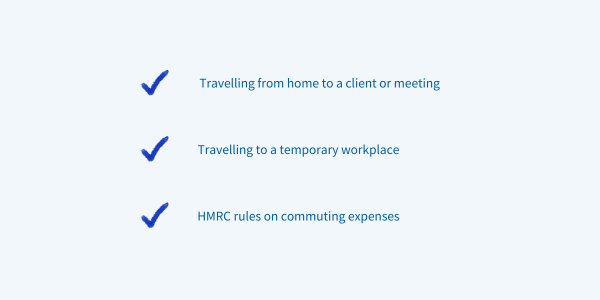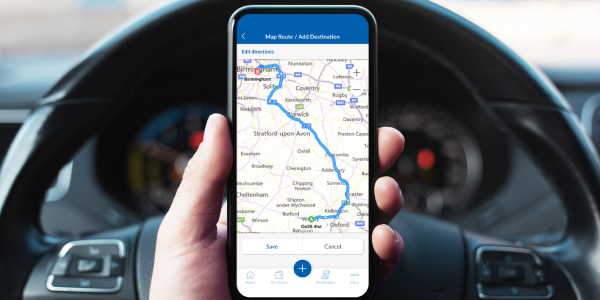
Business mileage expenses: What can you actually claim?
The basic rule when claiming business mileage expenses is that only ‘business-related’ costs should be reimbursed.
It sounds simple, but the reality is actually a little more complicated. Businesses often lose money by reimbursing unnecessary travel costs, and raise the risks of compliance breaches.
So, what does count as a legitimate business mileage expense? In this article, we’ll take a look at what the general guidelines around business expenses are, and clear up some of the confusion surrounding claims.
What 𝘤𝘢𝘯'𝘵 employees claim as a business travel expense?
By starting off with what you can’t claim as a business mileage expense, it might make it a bit easier to understand what you can expense. As with most types of business expenses, it’s ultimately the choice for each employer to define their travel expense policy as long as it’s within the confines of the law, so these are some general travel expense ‘don'ts’.
Can employees claim home to work mileage as a business expense?
The simple answer is no.
Work-related journeys as a general rule are those that take place within working hours. Travelling to your workplace is classed as a private journey as it takes place before the workday has begun, meaning it does not qualify as a business mileage expense.
This is based on the guidance provided by the tax authorities. For financial compliance, it simplifies the process of following these guidelines.
Home to work mileage HMRC rules
For tax purposes, the HMRC makes it clear that any regular commute between a person’s home and their permanent workplace is classed as a ‘private’ journey, and therefore cannot be expensed.
Here’s HMRC’s definition of a ‘permanent workplace’:
“A place at which an employee works is a permanent workplace if he or she attends it regularly for the performance of the duties of the employment. It is usually clear whether or not a place is an employee’s permanent workplace (and, therefore, whether a journey to that place is ordinary commuting).”
What 𝘤𝘢𝘯 employees claim business mileage expenses for?

For reasons relating to tax, legitimate business mileage expenses are only those mileage costs that are over and above a person’s normal travel to work-routine. Here are a few journeys that might be included in this:
Travelling from home to a client or meeting
Claiming travel when visiting a client or attending a meeting is dependent on how far the journey takes you. If your usual commute to your permanent workplace is four miles but you’re claiming travel to an off-site meeting 16 miles away, your usual four-mile commuting distance can be deducted. This deduction is often referred to as “off-set mileage”.
This off-setting method is commonly used by public sector organisations. It allows employees to be flexible, while making sure employers are covering only the business-related part of the journey.
Travelling to a temporary workplace
Expenses for mileage may be reimbursed if you’re travelling to a temporary work place. Some of the criteria for a ‘temporary workplace’ includes:
- If the employee works there for less than 24 hours
- If they are at the location for less than 40% of their time
HMRC rules on commuting expenses
The HMRC allows tax relief to be claimed on ‘business-related’ journeys that meet one of two criteria:
- An employee needs to make a trip to do their work
- Their work requires them to visit a location other than their normal workplace
This covers the vast majority of regular business trips. Whether it’s attending a meeting, picking up office supplies, or travelling between various company sites.
How can Webexpenses help ‘offset mileage’ for business mileage reimbursement?
Digital expense management tools that include a mileage tracking app, like Webexpenses, are making it much simpler to effectively offset business mileage expenses.

What is the issue?
Traditionally, finance teams have been slow to off-set mileage due to the administrative complexity of the process. With a manual method, users or admins would be required to calculate the distance by manually deducting these ‘private’ trips from mileage claims.
What's the solution
Technology has made this process much easier and faster. Here’s how:
- Finance teams can set individual's commutable mileage within their user profile
- Mileage can be tracked in-app for better visibility
- Mileage claims that involve travel from the person’s home are automatically deducted from the commuting distance
- Only the ‘business’ portion of the journey is reimbursed
This saves businesses time by cutting out the manual work, while also saving them money on unnecessary costs, and increasing compliance.
Book a demo to see how Webexpenses can simplify your business mileage expenses
When you enquire with Webexpenses you’ll receive bespoke advice relevant to your business needs. Find out how we can help streamline your business mileage expense management.
